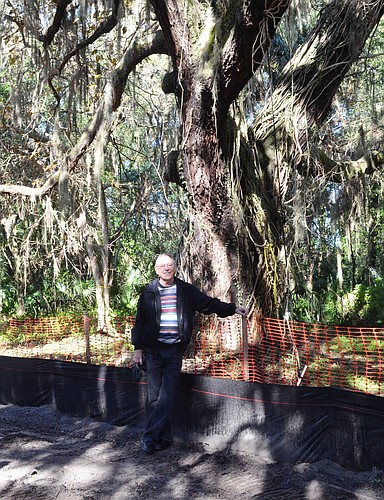- November 28, 2024
-
-
Loading

Loading

“Thank goodness it’s still here,” said Skip Lowery, speaking of the historic oak tree within earshot of bustling, midday Granada Boulevard.
The tree and another one nearby, also with plus-50-inch diameter, are in back of the land being cleared across the boulevard from Lowe’s Home Improvement.
“I just wanted to write it before I forget everything.”
SKIP LOWERY, author of ‘Ormond Boy’
Temporary fences surround the trees, protecting them from the bulldozers and other snorting equipment rolling around the future site of a VyStar Credit Union. Several other trees are also marked to be saved.
“Construction is going to happen, but we try to keep as much nature as possible,” said the construction foreman, who guided Lowery back to the tree.
Lowery has special memories of the tree. He wrote about it in “Ormond Boy,” a memoir of growing up in the 1950s, published in 2014. The tree provided shade for many get-togethers with a close friend who lived in a house next to the tree. A hunter, he would cook swamp cabbage and serve game and fish.
Book of memories
The book is a personal memoir, describing midcentury Ormond Beach life, but evokes memories of growing up for any reader. It’s available at the Ormond Beach Historical Society.
Lowery and I stopped to check the tree while on a tour of the city. He was describing to me how the town, then more of village, looked in the 1950s.
Now a busy four-lane highway, Granada Boulevard started at the railroad track and was two lanes all the way to the ocean.
Heading east, we passed the mobile home park, which is still there today. It was newer and fresher, of course, and stretched all the way to Granada.
Lowery lived in the trailer park and remembers that on the other side of some woods, there was a black neighborhood, where he had several friends. He knew kids who had never seen the ocean, because if a black person did not work at the golf course or hotel, they were not allowed on the peninsula.
Where the police station stands today was Big Field, where neighborhood kids played a variety of games, along with a recreation center, precursors to the Sports Complex and the neighborhood centers.
A bridge to the future
Lowery says he has been around long enough that he’s on his third bridge over the Halifax River. The first bridge had the remains of a railroad track beside it that Henry Flagler built to deliver passengers to the Ormond Hotel.
In 1954, a wooden drawbridge was constructed. Lowery would ride his bike in the traffic lane, but only three or four cars would have to go around him as he pedaled across.
Traffic was such a nonfactor, that the town closed off Granada Boulevard for “Sadie Hawkins Day,” where girls chased the boys.
“Can you imagine closing that road today?” he said.
He talks about the Sadie Hawkins Day custom in the book, along with other humorous stories.
The current Granada Bridge was built in 1983, with four lanes to accommodate a growing population.
The beach brings back memories of driving at night, bonfires and parties. He believes a traffic fatality on the beach at night spurred the eventual closing.
He admits that people remember things differently, and the book contains his personal memories.
“I just wanted to write it before I forget everything,” he said.
Ormond Beach is still a great beachside town, he says, and he has always loved it.
But thinking about the old days and the growing population, he wonders about the future.
“What are they going to do about Granada Boulevard?” he asks.